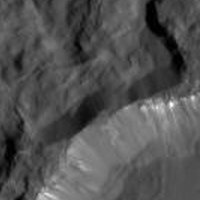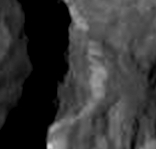Ceres High Altitude Mapping Orbit (HAMO), Late summer through fall 2015 |

  |
Ceres High Altitude Mapping Orbit (HAMO), Late summer through fall 2015 |
 Aug 31 2015, 05:32 PM Aug 31 2015, 05:32 PM
Post
#61
|
|
 Member    Group: Members Posts: 555 Joined: 27-September 10 Member No.: 5458 |
Processed enlargement of HAMO 6.
 (click to enlarge) Any ideas on the rough patch on the northern side of the crater rim? Strange feature I haven't seen before. Floor of the crater is really interesting with a sinuous path of something... On the northern outside of the crater, appears to have been a landslide, while the south side looks like it has slumped some but also looks like it could have been caused by a much less viscous flow into the nearby depression. Very rough on the western edge as well. This seems pretty consistent with other craters with the white material. -------------------- |
|
|
|
 Aug 31 2015, 06:15 PM Aug 31 2015, 06:15 PM
Post
#62
|
|
 Junior Member   Group: Members Posts: 37 Joined: 21-December 05 Member No.: 614 |
Looking at the latest pictures I sometimes wonder if Ceres is just full of sinkholes
|
|
|
|
 Aug 31 2015, 06:25 PM Aug 31 2015, 06:25 PM
Post
#63
|
|
|
Senior Member     Group: Members Posts: 2998 Joined: 30-October 04 Member No.: 105 |
HO-6 is related to Survey Orbit image SO-22 and is located NE of the crater Toharu. It is an unusual Facula because it is located on a Highland area and not on a Lowland plain. This type of bright spot is evidently related to impact ejecta disturbing a zone of light-toned material, whereas the other type of Facula may be related to be an effusive process related to hydrothermal activity.
And looks to be a lot of mass-wasting (slumping) around this crater. And if you look closely there is a lineation (and possibly a line of craters) on the NW rim, cutting through alluvial fans at floor level. https://univ.smugmug.com/Dawn-Mission/Ceres...s3x--enh2-L.png Just an arm-waving guess, seeing how the puzzle-pieces are fitting together. I'll also guess that the Haulani crater area will be up within the next couple of orbits. And this, the Third Day of HAMO... --Bill -------------------- |
|
|
|
 Aug 31 2015, 07:10 PM Aug 31 2015, 07:10 PM
Post
#64
|
|
 Member    Group: Members Posts: 423 Joined: 13-November 14 From: Norway Member No.: 7310 |
Ah, now it strikes me that this area is very similar in appearance to the trough-shaped "appendage" of the crater from the previous HAMO image (they are both roughly rectangular).
 It does indeed look like it could be a landslide of sorts, one that went away from the crater rather than into it. The end result is a locally (relatively) symmetric crater wall, with slopes of similar steepness on both sides of the crater rim. This topographic feature (note the shadows), partially shown in the previous cropped image, is also very interesting . My eyes want me to believe that there is an overhang in the middle there (the part with a "finger" sticking out), but I don't know if that's even possible to tell from this image.  And, uh, isn't that a plateau on the crater rim? I am starting to like this crater.  As for the overall appearance of the crater, I am reminded of the way crater ejecta on Mars is interpreted: certain ejecta blankets are thought to be caused by subsurface water. Since Ceres is supposedly full of water, it makes sense to me that impacts here may temporarily liquefy water close to the surface and create a 'mud splash', as is thought to happen on Mars. -------------------- |
|
|
|
 Aug 31 2015, 07:58 PM Aug 31 2015, 07:58 PM
Post
#65
|
|
 Senior Member     Group: Members Posts: 1887 Joined: 20-November 04 From: Iowa Member No.: 110 |
It appears that there may be unevenly distributed bright material hidden below a regolith which is being revealed by landslides. The bright spots in the center of some of the craters may be just the most recent places where it has reached the surface.
|
|
|
|
 Aug 31 2015, 11:56 PM Aug 31 2015, 11:56 PM
Post
#66
|
|
|
Merciless Robot     Group: Admin Posts: 8783 Joined: 8-December 05 From: Los Angeles Member No.: 602 |
Huh. There seem to be a fairly large number of mass-wasting events scattered around, all of which have a relatively fresh appearance. I wonder if Ceres' upper crust is somewhat fragile due to the presence of volatiles and the effects of solar heating; might not take much to trigger an avalanche, might take nothing more than enough solar exposure over time.
Oddly dynamic-looking little world, getting odder with every image. -------------------- A few will take this knowledge and use this power of a dream realized as a force for change, an impetus for further discovery to make less ancient dreams real.
|
|
|
|
 Sep 1 2015, 01:09 AM Sep 1 2015, 01:09 AM
Post
#67
|
||
 Member    Group: Members Posts: 714 Joined: 3-January 08 Member No.: 3995 |
Some observations and thoughts on the recent HAMO release (some points mentioned in posts above):
1. The bits of white stuff in the upper parts of the crater wall are interesting as always. Similar features in craters on Vesta and Phoebe come to mind. 2. There is an almost complete (if not complete) lack of discernable craters of any size within the big fresh crater or its ejecta sheet. This is an indication of a very young crater, very recent mass-wasting events, or both. 3. The ejecta sheet has a degraded look to it. It is as if the material subsided or collapsed in places. 4. There is a straight linear feature (fracture?) running along the base of the wall from 9:30 to 11:30. 5. There appears to be a sinuous 'rille' running the length of the large valley on the north side. |
|
|
|
||
 Sep 1 2015, 02:28 PM Sep 1 2015, 02:28 PM
Post
#68
|
|
|
Senior Member     Group: Members Posts: 2998 Joined: 30-October 04 Member No.: 105 |
...
-------------------- |
|
|
|
 Sep 1 2015, 02:40 PM Sep 1 2015, 02:40 PM
Post
#69
|
|
 Member    Group: Members Posts: 555 Joined: 27-September 10 Member No.: 5458 |
Care to expand on that Bill? I've looked at the image with the gamma turned up already and didn't see too much to be revealed.
-------------------- |
|
|
|
 Sep 1 2015, 02:53 PM Sep 1 2015, 02:53 PM
Post
#70
|
|
|
Member    Group: Members Posts: 148 Joined: 9-August 11 From: Mason, TX Member No.: 6108 |
I agree that this crater is clearly a relatively fresh impact crater, but I suspect it is too small to have been a cause for any fractures or visible changes to the surface other than the obvious ejecta and some later slumping indicated by the detritus in the basin. The crater south of Tall Mountain seems quite a bit different to me in that it has no obvious ejecta and the basin floor looks suspiciously like the plains surface surrounding it. I'm strongly reminded of the sinkholes here in the Texas limestone country where the surface texture pretty much collapses intact into failed caverns, and naturally with no upheaval/ejecta material around them. So that's in the back of my mind as I compare the two craters (and ponder what subsurface activity may also account for the formation of Tall Mountain beside it--I am now under the impression that all the large craters around Tall Mountain may in fact be linked by subsurface activity).
-------------------- --
Don |
|
|
|
 Sep 1 2015, 04:08 PM Sep 1 2015, 04:08 PM
Post
#71
|
|
 Member    Group: Members Posts: 555 Joined: 27-September 10 Member No.: 5458 |
Processed enlargement of HAMO 7.
 (click to enlarge) Can't say with any certainty but the feature at the top left in the image has a very large shadow for its apparent size and may be a slight overhang. -------------------- |
|
|
|
 Sep 1 2015, 09:00 PM Sep 1 2015, 09:00 PM
Post
#72
|
||
|
Junior Member   Group: Members Posts: 20 Joined: 9-August 08 From: Lucens, CH Member No.: 4309 |
Some observations and thoughts on the recent HAMO release (some points mentioned in posts above): 1. The bits of white stuff in the upper parts of the crater wall are interesting as always. Similar features in craters on Vesta and Phoebe come to mind. 2. There is an almost complete (if not complete) lack of discernable craters of any size within the big fresh crater or its ejecta sheet. This is an indication of a very young crater, very recent mass-wasting events, or both. 3. The ejecta sheet has a degraded look to it. It is as if the material subsided or collapsed in places. 4. There is a straight linear feature (fracture?) running along the base of the wall from 9:30 to 11:30. 5. There appears to be a sinuous 'rille' running the length of the large valley on the north side. The feature at 9 o'clock (number 3) reminds me of "half Tall Mountain". Tall Mountain is also very close to the rim of a crater. Could it be that the impacts lifted part of the surface à la pingo? Maybe the angle of impact makes a difference? |
|
|
|
||
 Sep 1 2015, 10:26 PM Sep 1 2015, 10:26 PM
Post
#73
|
|
|
Senior Member     Group: Members Posts: 2998 Joined: 30-October 04 Member No.: 105 |
HAMO-7 is an example of crater internal slumpage:
http://photojournal.jpl.nasa.gov/catalog/PIA19883 The large crater is Toharu --Bill -------------------- |
|
|
|
 Sep 2 2015, 12:01 AM Sep 2 2015, 12:01 AM
Post
#74
|
|
|
Newbie  Group: Members Posts: 6 Joined: 17-November 14 Member No.: 7331 |
QUOTE ZLD: Can't say with any certainty but the feature at the top left in the image has a very large shadow for its apparent size and may be a slight overhang. I think the crater in the center of HAMO 7 is Toharu and the shadow on its left another big one  http://foro.sondasespaciales.com/index.php...1.msg130295#new |
|
|
|
 Sep 2 2015, 04:36 PM Sep 2 2015, 04:36 PM
Post
#75
|
|
 Member    Group: Members Posts: 555 Joined: 27-September 10 Member No.: 5458 |
Processed enlargement of HAMO 8.
 Seems the compression is much higher on this image than the past several HAMO TIFFs. Not sure why. Not many new revealing items in this release. One feature of note is the bright spot, previously visible as just a white blob in SO10, SO19, SO40, SO42, is indeed a crater, very similar in appearance to Haulani and other craters with the white material, just on a much smaller scale. Also, another crater to the north that is caving inward. -------------------- |
|
|
|
  |

|
Lo-Fi Version | Time is now: 5th May 2024 - 03:11 PM |
|
RULES AND GUIDELINES Please read the Forum Rules and Guidelines before posting. IMAGE COPYRIGHT |
OPINIONS AND MODERATION Opinions expressed on UnmannedSpaceflight.com are those of the individual posters and do not necessarily reflect the opinions of UnmannedSpaceflight.com or The Planetary Society. The all-volunteer UnmannedSpaceflight.com moderation team is wholly independent of The Planetary Society. The Planetary Society has no influence over decisions made by the UnmannedSpaceflight.com moderators. |
SUPPORT THE FORUM Unmannedspaceflight.com is funded by the Planetary Society. Please consider supporting our work and many other projects by donating to the Society or becoming a member. |

|